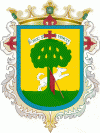Zapopan
 |
 |
The name Zapopan means "among the sapote trees". It derives from the Nahuatl word tzapotl "sapote" with the addition of the locative suffix -pan. It also has the nickname of “ex Villa Maicera” ("former Corn Village"), as it used to be a major producer of corn. Its seal was designed by José Trinidad Laris in 1941 for the 400th anniversary of the city's founding.
From 1160 to 1325 many Zapotec, Nahua and Maya families migrated into this area from the south, with many settling in the Profundo Arroyo area. These first settlers eventually mixed among themselves and with newcomers such as Aztecs and eventually were known as Tecos. Many small shrines called “cues” were built here, mostly to worship the sun, although the primary deity was a god-child called Teopiltzintli or the corn god.
By the time the Spanish arrived, Tzapopan was a fairly large settlement, but it was in decline due to wars with various surrounding nomadic tribes. It was subject to the dominion of Atemajac, also called Tlatoanazgo, which itself was subject to the Hueytlatoanazgo of Tonalá.
In 1530, this area was subdued by Nuño de Guzmán, but the establishment of a Spanish settlement of Zapopan did not happen until 1541 due to the Mixtón War. In that year Francisco de Bobadilla, encomendero of Tlatltenango moved 130 Indians from his lands to repopulate Zapopan. Accompanying them was an image of Our Lady of the Conception, which had traveled to areas like Zacatecas as part of evangelization efforts. This statue would eventually take on the name of Our Lady of Zapopan. The sanctuary for this image was begun in 1689.
In 1824, Zapopan was named as the seat of one of the 26 department of the newly created state of Jalisco. When the departments were reorganized in 1837, it retained its status as seat. In 1873, General Ramon Corona fought against rebel forces led by Manuel Lozada “El Tigre de Alica” at Rancho de la Mojonera.
In 1979, Pope John Paul II visited the Basilica of Our Lady of Zapopan.
In 1991, the town gained city status in a ceremony that took place on 8 December, the 450th anniversary of the city's foundation.
The flag of Zapopan is derived from a Nahuatl pictogram represented by the fruit tree of sapotes with a flag on its side. The name Zapopan comes from the Nahuatl word tzapopan, "place of sapotes". Zapopan is the second most populous municipality in Jalisco and is the seventh most populous municipality in Mexico. During the solemn session held on December 8, 1991, in which the 450th anniversary of the repopulation of the Villa Zapopan was celebrated, it was awarded the title of city. The tourist attractions offered by Zapopan are diverse; from important religious points nationwide to world-class shopping malls. It also has different alternatives for ecological tourism such as El Diente, Bosque de La Primavera, among others. Within this municipality are located the best hotels in the Metropolitan Area, the largest show centers in Jalisco and museums that host exhibitions of local and international significance. One of the most important religious celebrations at the national level, the pilgrimage of the Virgin of Zapopan. takes place in the same municipal seat. On October 12 thousands of Catholic faithful come to witness the return of "La Generala" to its compound, the Basilica of Zapopan. The typical food is the same as in the other municipalities that make up the Metropolitan Area but it is worth highlighting the elaboration of cymbals based on the corn, which is the tender corn cob. Zapopan is also known as the "Villa Exmaicera" due to the large amount of expanse planted of this agricultural product.
Map - Zapopan
Map
Country - Mexico
Currency / Language
| ISO | Currency | Symbol | Significant figures |
|---|---|---|---|
| MXV | Mexican Unidad de Inversion | 2 | |
| MXN | Mexican peso | $ | 2 |
| ISO | Language |
|---|---|
| ES | Spanish language |


















